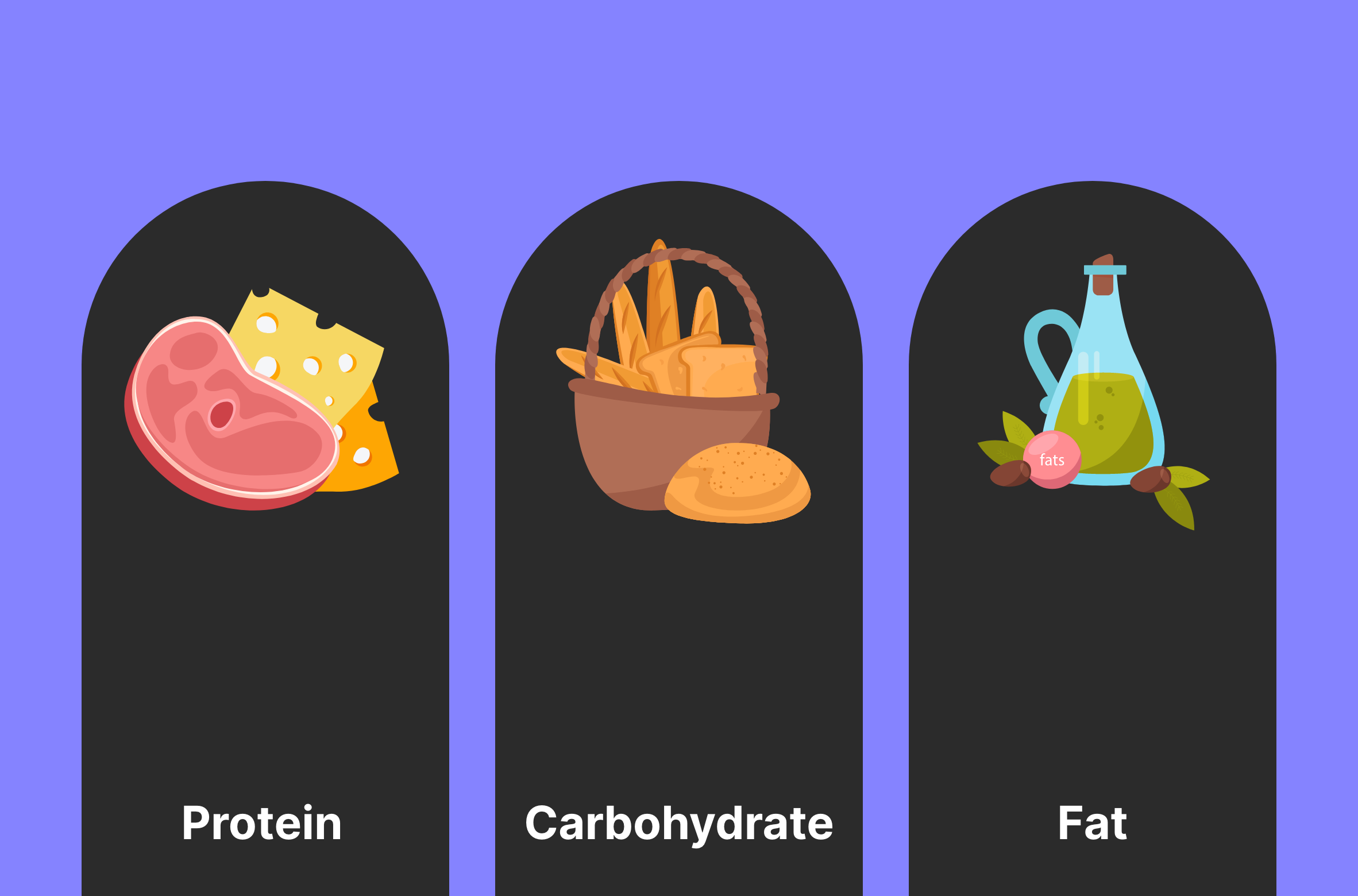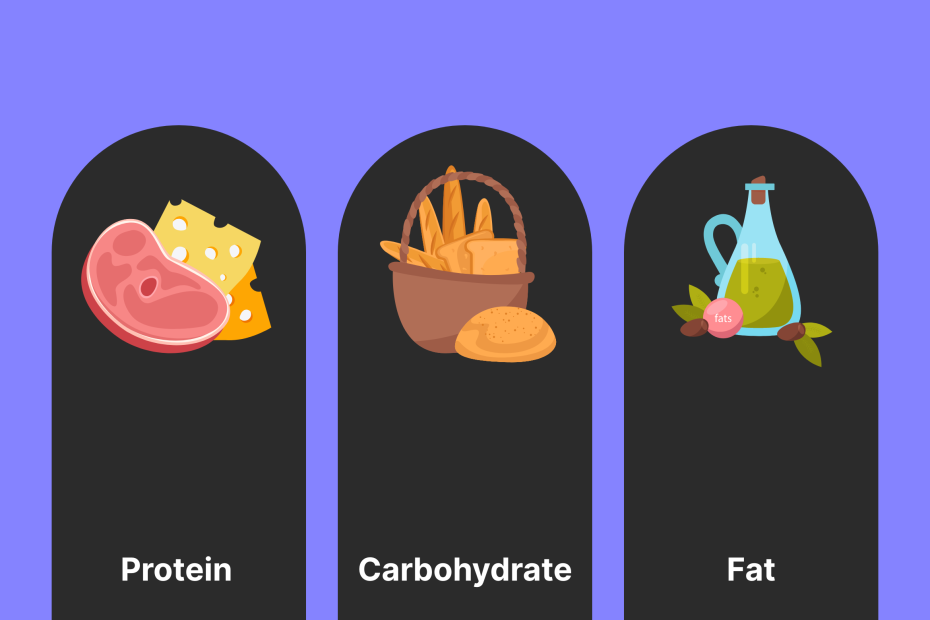Macronutrients
- Macronutrients contain energy and are needed in large quantities for health and survival.
- Proteins, carbohydrates, and fats are the 3 macronutrients.
- Amino acids make up proteins and are the building blocks for life.
- Carbohydrates are the main fuel source for our body and are categorized as starch, sugar, and fiber.
- Omega-3 fats, found in seafood and walnuts, are essential for life and most people don’t eat enough of them.
- Eat the rainbow, know your protein intake, and be weary of “low fat” labels.
Every day at every meal, we consume macronutrients, but most people don’t know what a macronutrient is – do you? To understand what macronutrients are, we can first break down the word into two parts: “macro” and “nutrients.” “Macro” means big and “nutrients” are something we eat or drink for health and survival. With that said, we can understand the term “macronutrients” to mean the foods or beverages (nutrients) we consume in large quantities (macro) in order to grow and maintain life (health and survival). We also consume micronutrients every time we eat, which, as you guessed it, are nutrients we consume in small quantities, but this blog will focus on macronutrients.
Macronutrients contain energy, which is referred to as calories. They are also considered essential, meaning we need to consume them regularly in order to survive. If we don’t consume macronutrients, then we will have to rely on our body’s limited storage of energy. We store a small amount of energy as sugar and the rest is stored as fat. Energy is required for our body to perform nearly any function, so if we rely solely on our body’s stores then eventually we will start to break down and use structural components, like muscle, for energy. Even when we want to lose weight, we do not want to lose muscle, which is why we still need to eat, albeit less, during weight loss. Now, you might understand what the term “macronutrients” means and why they are important, but what are macronutrients?
What are macronutrients?
The food we consume is divided into three broad categories: proteins, carbohydrates (or carbs), and fats – jump to page 5 for a list of foods in each category. These three components and water are what we define as macronutrients. It is easy to separate foods based on which macronutrient they contain, but most foods tend to have some of each macronutrient. For instance, bread is mostly carbohydrate, but it also contains some protein and sometimes fat. Therefore, we generally consider bread as a carb. Herein, when discussing foods, we will categorize them into which macronutrient the food contains the most of, e.g. bread will be categorized as a carb.
- Proteins provide the body with amino acids, which are the building blocks of life. Amino acids are responsible for the structure of our body, like muscle, repairing cells and body tissues, fighting infections and inflammation, and so much more. We do not have a storage pool of amino acids in our body, and they are constantly being turned over. Therefore, we need a steady and consistent supply through our diet. There are 20 different amino acids, and 9 of them are essential. Since our body cannot make the essential amino acids and we do not have a storage pool, we must consume them through our diet. All animal sources of protein, from beef to eggs to milk, are considered complete, meaning they contain all of the essential amino acids. Most people eat plenty of protein, so we usually don’t have to worry about consuming enough. Protein is found in foods like chicken, beef, pork, fish, shellfish, eggs, and soybeans and legumes.
- Carbohydrates are our body’s primary fuel source – carbs are to humans what gasoline is to a car. They are abundant in our diet and come in a few different forms: starch, sugar, and fiber. Starch and sugar get quickly broken down into a type of sugar called glucose, which is what our body uses for energy. Some glucose gets stored in our body and can be used as a short-term supply of energy. On the other hand, fiber does not get taken up by our body. It slows the digestion of other foods making us feel fuller for longer, and it helps keep the microbes in our gut healthy. Carbs are found in a variety of foods like breads, cereals, fruits, vegetables, and legumes.
- Dietary fat is important to maintain healthy cells, absorb micronutrients, proper brain function, and energy. Fats are categorized based on their structure and can be found as unsaturated, saturated, or trans forms. Unsaturated fats are generally considered healthy and are liquid at room temperature, like olive oil. Two types of unsaturated fats, omega-3 and omega-6, are essential, so we have to eat them through our diet. Omega-3 fats are found in seafood and walnuts and most people don’t consume enough of them. Omega-6 fats are abundant in our diet and found in foods like corn oil. Saturated fat is usually found in animal foods, like beef and cheese, and is solid at room temperature, like butter or fatty marbling on a steak. Saturated fat should be limited in our diet. Trans fats are dangerous and should be avoided because they increase our risk for heart disease. Some animal foods contain a small amount of trans fats, but most trans fat is created through industrial processes to preserve the taste and texture of fat-containing foods. Trans fats were banned in the United States in 2018, so most foods contain little if any trans fat.
What should I eat?
There are countless diets, trends, and misinformation campaigns about what we should eat and how much. The general recommendation for macronutrient intake is 45-65% of your daily calories from carbs, 20-35% from fats, and 10-35% from protein. The grams of protein, carbs, or fat in a food can be used to figure out how many calories are in a food. Carbohydrates and proteins have 4 calories per gram, so a food with 8 grams of carbohydrate and 3 grams of protein will have 44 calories (8+3 = 11 → 11×4 = 44). Fats have 9 calories per gram, so a food with 10 grams of fat will have 90 calories (10×9 = 90). Although these guidelines can be helpful, they leave out a very important component, which is what we should eat. Here are some key recommendations for what we should eat and how much.
- Eat the rainbow. To guarantee a balanced diet, try to fill your plate with a variety of colors. We often see plates full of white colored foods like white bread, pasta, rice, and potatoes. Adding red, orange, dark green, and purple foods to your plate will guarantee a variety of fruits and vegetables on your plate. Aim to eat 2 cups of fruit and 2 ½ cups of vegetables each day. One cup is about a handful. We also want to avoid processed fruits and vegetables, like canned or juiced options.
- Too much protein? Healthy people should eat about 0.8 grams of protein per kilogram of body weight per day. To convert your weight to kilograms, simply divide your weight in pounds by 2.2. Then, multiply that number by 0.8 to get the amount of grams of protein you need each day. For example, if you weigh 150lbs: 150/2.2 = 68 kgs → 68×0.8 = 54.5 grams of protein per day. A serving of protein is 3 ounces, which is about the size of a deck of cards or the palm of your hand. The amount of protein in a serving of protein can vary depending on the source. A serving of chicken has about 26 grams of protein and a serving of beef has about 23 grams of protein.
- Be weary of “low fat” foods. For a long time fat-containing foods were deemed an enemy. It is true that we should aim for no more than 10% of our daily calories from saturated fat, however many foods that are labeled “low fat” tend to have a lot of sugar added to compensate for the change in flavor. If you encounter a food labeled “low fat”, take a moment to consider its added sugar content. Added sugar has been shown to increase risks for heart disease and other diseases, like diabetes, so it should be avoided.
Take Home Message
Macronutrients are foods or beverages we consume in large quantities in order to maintain health and survival. We need macronutrients because they provide us with a steady supply of energy. All three of the macronutrients (proteins, carbs, and fats) are important in their own ways, which is why we need to consume all of them. During meal times, look to the rainbow to ensure you are consuming a wide variety of fresh fruits and vegetables. You can feel confident you are consuming enough protein by using the 0.8 grams of protein per kilogram body weight calculation. Lastly, look out for hidden added sugars on foods labeled “low fat.” Look below to test your knowledge and for a list of foods found in each macronutrient category.
Test Your Knowledge
What macronutrients do we use for energy?
a) Carbs only
b) Fats and proteins
c) Proteins, carbs, and fats
d) Proteins only
Correct answer: c. Proteins, carbs, and fats
Explained: Our body prefers to use carbs and fats for fuel. If there are no carbs or fats available then our body will break down proteins to use for energy.
Macronutrients
Below is a limited list of foods within each macronutrient category. Some foods fit into multiple categories, while others are primarily in one category.
| Proteins | Carbs | Fats |
| – Beef
– Chicken – Turkey – Pork – Eggs – Beans – Soybeans – Tofu – Tempeh – Quinoa – Greek Yogurt |
Starch:
– Bread – Rice – Pasta – Potato – Peas – Corn – Oatmeal – Breakfast cereal
Sugar: – Soda – Breakfast cereal – Cakes – Ice cream – Sports drinks – Yogurt – Sweetened coffee or tea – Fruit
Fiber: – All vegetables – All fruit – Beans – Lentils – Whole grain bread – Whole grain pasta |
Unsaturated:
– Nuts: almonds, walnuts, cashews, macadamia – Seeds: pumpkin, sesame, sunflower, flax – Salmon – Tuna – Avocado
Saturated: – Beef – Cheese – Butter – Whole fat milk and ice cream – Cured meats: salami, pepperoni, prosciutto – Pork, bacon, and sausage – Cream cheese – Sour cream
Trans: – Commercial baked goods: cakes, pies, pastries, cookies – Microwave popcorn – Fried foods – Shortening |
References
1. Boston 677 Huntington Avenue, Ma 02115 +1495‑1000. Carbohydrates. The Nutrition Source. Published September 18, 2012. Accessed October 28, 2022. https://www.hsph.harvard.edu/nutritionsource/carbohydrates/
2. Dernini S, Berry EM. Mediterranean Diet: From a Healthy Diet to a Sustainable Dietary Pattern. Front Nutr. 2015;2. Accessed October 31, 2022. https://www.frontiersin.org/articles/10.3389/fnut.2015.00015
3. Vannice G, Rasmussen H. Position of the Academy of Nutrition and Dietetics: Dietary Fatty Acids for Healthy Adults. J Acad Nutr Diet. 2014;114(1):136-153. doi:10.1016/j.jand.2013.11.001
4. DiNicolantonio JJ, Lucan SC, O’Keefe JH. The Evidence for Saturated Fat and for Sugar Related to Coronary Heart Disease. Prog Cardiovasc Dis. 2016;58(5):464-472. doi:10.1016/j.pcad.2015.11.006
5. What are Proteins and What is Their Function in the Body? Accessed October 28, 2022. https://www.eufic.org/en/whats-in-food/article/what-are-proteins-and-what– is-their-function-in-the-body
 share
share



